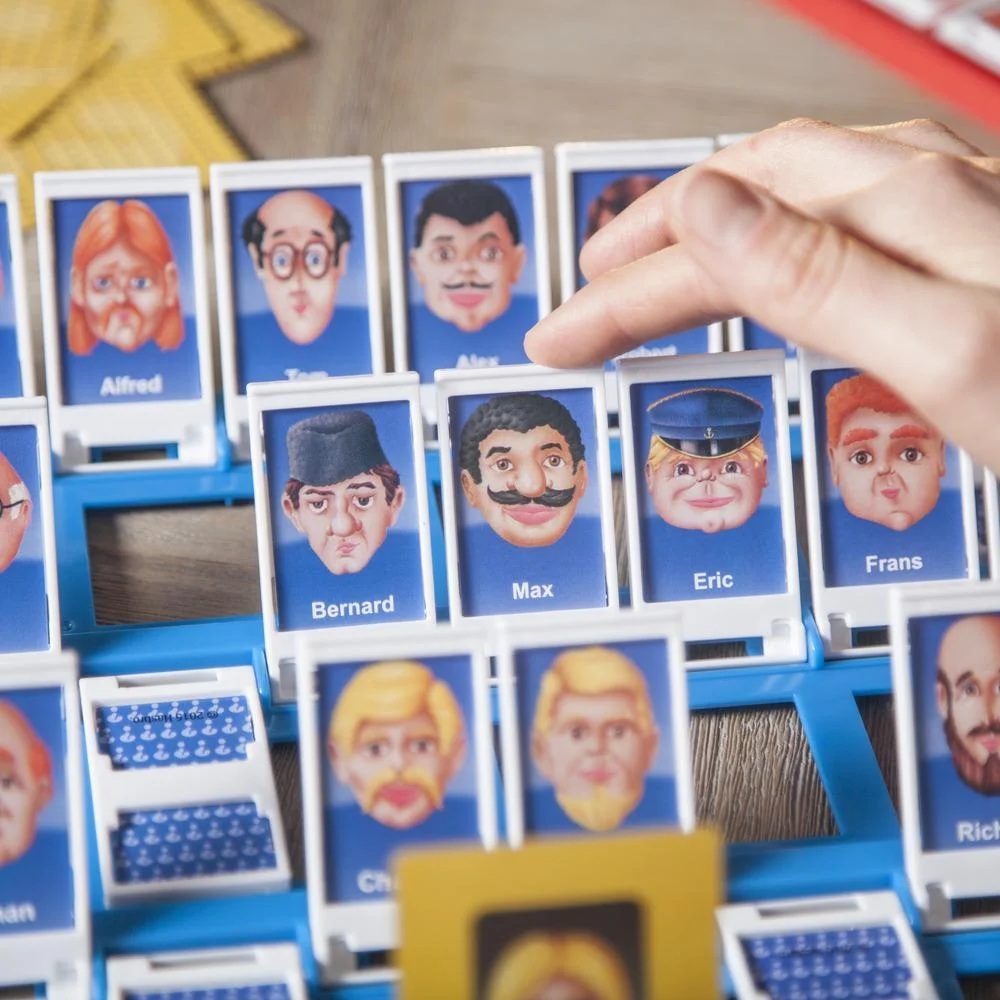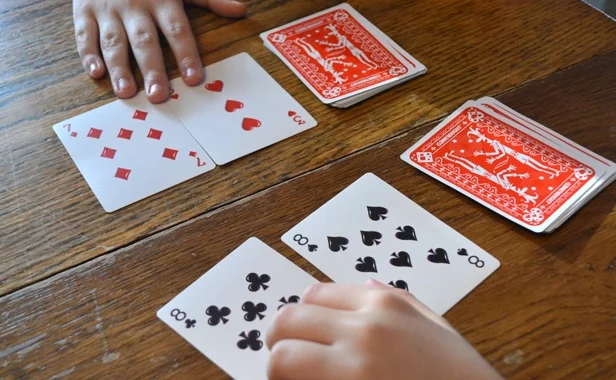Y'all.
Last week my principal approved my dream course: a semester-long elective on math games and art at the middle school where I teach.
I am ecstatic! For the next nine weeks, I get to spend one period each day just playing games with 8th graders and investigating the math that they contain. After that, we'll be creating math art inspired by some of my favorite artists, such as Regolo Bizzi (pictured). I can't imagine a more fun class to teach.
I was wondering how to start the course. What math topic should I introduce first? And I settled on one of the most fundamental questions that a kid can ask: Is this game fair?
So I used the simplest game I could think of to investigate that concept: Sum Dice
Do you still remember the faces from the original Guess Who game? I do. The big noses, the rosy cheeks. The...interesting skull shapes.
I mean, just look at Bill. Poor Bill. The guy looks like a pink raindrop with facial hair. I mean, he's a happy pink raindrop with facial hair, but still...
The game has gone through several much-needed printings since the 80s, adding more women and people of color to the mix. But you can still find the classic version if you so choose.
And I do recommend that you find a version you like, because your kid will definitely want to play Guess Who? a bunch! There's a reason the game was such a smash hit when it came out 30 years ago: the rules are simple, the play is quick, and the competition is fierce!
My first year of teaching, I really had no clue what I was doing. I was terrified to teach my first lesson, since I had no idea what my students did and didn't know. So I grabbed an activity that I had first seen in my Master's program: The Product Game.
Read MoreThis week's game was recommended to me by my friend Katie Charner-Laird, a parent of two kids and a principal in Cambridge, Massachusetts. She recently started a math games club at her elementary school, and she said that Zeus on the Loose was one of her students' absolute favorites to play.
Read MoreYou know Tenzi; it's that tube of multicolored dice that suddenly appeared in every toy store in America a few years ago.
I bought the game and played it with my kids a year or so ago, but I wasn't sure how mathematical the game was at its core. Other than learning how to recognize, or subitize, the number on each side of the dice, where could I find the math?
Then I bought the companion piece, 77 Ways to Play Tenzi. Some of the games are ridiculous and silly, while others are really interesting mathematical games. Best of all, they all incorporate the most fun and addictive aspect of Tenzi: frantically rolling a ton of multi-colored dice.
Years ago, a teacher friend sent me an online version of the game Nim. "Try it out!" they said innocently enough, "See if you can figure out the strategy!"
The game seemed simple enough, basically just a set of three rows of objects. So I gave it a shot, and I lost. And then I lost again, and again. I finally walked away from my computer, a broken man.
In the years since then, I've moved cities and schools, had three kids, and STILL CANNOT BEAT THIS GAME.
In preparation for this newsletter, I finally gave in and looked up the solution. And having seen a lovely explanation from one of my favorite mathematicians, James Tanton, I think I can provide a way to turn this maddening little game into a meaningful mathematical exploration for you and your child.
Do you have a Sharpie handy? I hope so, because today we are going to be defacing a classic game, Connect 4!
Connect 4 doesn't need any improvement, honestly. The game is great for young kids developing their fine motor skills and their spatial reasoning. But I found a lovely little variation from Catherine Reed at Brown Bag Teacher and I just had to try it with my son.
Periodically I pull out a math game in my 8th grade classes, usually when I have 20 minutes or so to kill after a field trip or standardized test.
In the past I've shared Magic Squares and The 100 Game, both of which I really enjoy introducing to my students. But I know how to beat both of those games, so I don't enjoy them as a participant in the same way that I enjoy games like chess or Blokus.
But there is one game I use with my students that captures my full attention: tic tac toe. But not the boring, solved version that you learned to beat when you were 6. I'm talking about Ultimate Tic Tac Toe.
I picked up Manifold at a game shop shortly before a flight I took recently. It turned out to be one of the most addictive puzzle games I've ever played. As soon as I solved one puzzle, I stuffed it in the front pocket of my backpack and tore off the next one.
By the time the plane landed, my backpack was practically brimming with folded puzzles. I had solved over half the puzzles and was feeling very accomplished (I had to skip #39, but I don't want to talk about it and I'm not mad.)
This game is aimed at older kids (10+) than most of the games I review for this newsletter. It's also one of the most engaging and unique puzzle-solving experiences I've ever had. I simply had to share it with you.
My greatest parenting regret is that I taught my son how to play War.
Don't get me wrong, he loves the game. In fact, that's precisely the problem. For weeks after I taught him the rules, War was the only game he let us play, and it got old fast.
If you haven't played War, it's a ridiculously simple card game. You deal the whole deck out to two players, and then both players flip over the top card. Highest card wins. If the cards are the same rank, both players put three cards face down and then flip over the fourth card. Again, the highest card wins the whole pile. The game continues until one person has all the cards.
The game is entirely driven by luck, and it can drag on for twenty or thirty minutes as one player, deck spilling over with forty-something cards, tries to win those last few pesky cards from their opponent.
To stave off the boredom, I started looking up some variants on War. As it turns out, some of these are really fun! Most importantly, they create opportunities for you and your kid to have a little math talk while playing.
I walked into the playroom holding a board game, which is a pretty routine occurrence in our household. "Hey J, do you want to play a game?"
"No."
"It has lasers..."
"OK!"
Since I showed my son this game, he has introduced it to his little sister, his cousins at the beach, and two different friends who have come over on playdates. He has also wandered our house, finding new mirrors he can use to bounce lasers onto furniture, framed photos, and annoyed family members.
In short, Laser Maze is a hit in the Haines household. J definitely doesn't think of Laser Maze as a math game, but I can already see him learning new concepts about angles of reflection and spatial relationships.
Occasionally he even lets me play, which is really fun because, again, there are lasers.
I truly believe that one reason I was a strong math student is that, when my mind wandered, it wandered in a mathematical direction. I noticed patterns, I developed strategies and shortcuts, and I generally became fluent at basic calculations, all without drilling my times tables.
My hope is that when you introduce your kids to little math games like One Dollar Words, their minds will start to wander mathematically as well.












